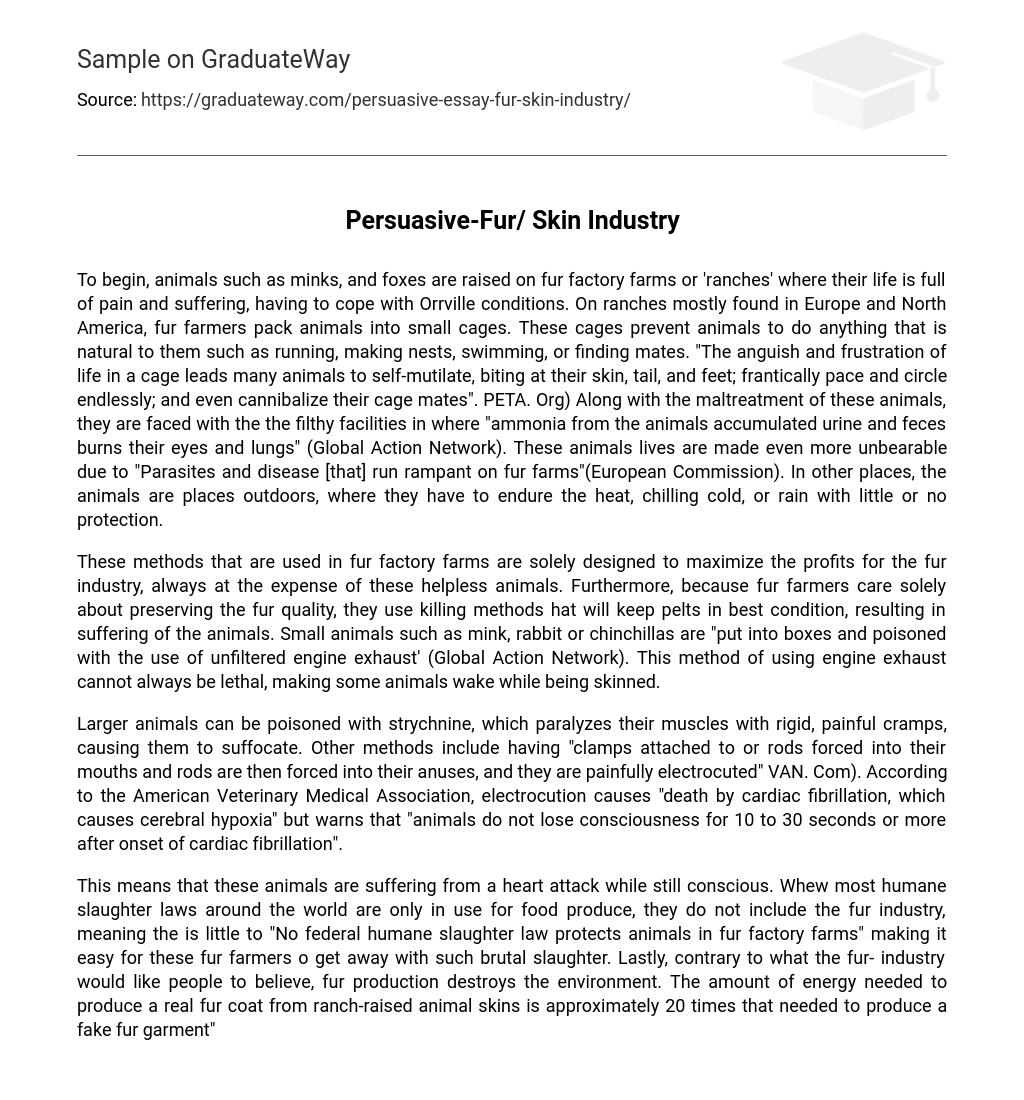To begin, animals such as minks, and foxes are raised on fur factory farms or ‘ranches’ where their life is full of pain and suffering, having to cope with Orrville conditions. On ranches mostly found in Europe and North America, fur farmers pack animals into small cages. These cages prevent animals to do anything that is natural to them such as running, making nests, swimming, or finding mates. “The anguish and frustration of life in a cage leads many animals to self-mutilate, biting at their skin, tail, and feet; frantically pace and circle endlessly; and even cannibalize their cage mates”. PETA. Org) Along with the maltreatment of these animals, they are faced with the the filthy facilities in where “ammonia from the animals accumulated urine and feces burns their eyes and lungs” (Global Action Network). These animals lives are made even more unbearable due to “Parasites and disease [that] run rampant on fur farms”(European Commission). In other places, the animals are places outdoors, where they have to endure the heat, chilling cold, or rain with little or no protection.
These methods that are used in fur factory farms are solely designed to maximize the profits for the fur industry, always at the expense of these helpless animals. Furthermore, because fur farmers care solely about preserving the fur quality, they use killing methods hat will keep pelts in best condition, resulting in suffering of the animals. Small animals such as mink, rabbit or chinchillas are “put into boxes and poisoned with the use of unfiltered engine exhaust’ (Global Action Network). This method of using engine exhaust cannot always be lethal, making some animals wake while being skinned.
Larger animals can be poisoned with strychnine, which paralyzes their muscles with rigid, painful cramps, causing them to suffocate. Other methods include having “clamps attached to or rods forced into their mouths and rods are then forced into their anuses, and they are painfully electrocuted” VAN. Com). According to the American Veterinary Medical Association, electrocution causes “death by cardiac fibrillation, which causes cerebral hypoxia” but warns that “animals do not lose consciousness for 10 to 30 seconds or more after onset of cardiac fibrillation”.
This means that these animals are suffering from a heart attack while still conscious. Whew most humane slaughter laws around the world are only in use for food produce, they do not include the fur industry, meaning the is little to “No federal humane slaughter law protects animals in fur factory farms” making it easy for these fur farmers o get away with such brutal slaughter. Lastly, contrary to what the fur- industry would like people to believe, fur production destroys the environment. The amount of energy needed to produce a real fur coat from ranch-raised animal skins is approximately 20 times that needed to produce a fake fur garment”(Gregory smith). While the unmanned (untreated) pelt is naturally biodegradable and therefore better for the environment, absolutely no unmanned coats are sold. All fur sold is chemically treated to stop the fur from rotting, but this chemical treatment is dangerous to water supply. Highly elevated levels of these chemicals can be found in the areas around fur Another factor is how the feces produced in the fur farms.
For example, “each mink skinned by fur farmers produces about 44 pounds of feces” (SO Bursars). Based on the “total number of minks skinned in North America, which was 2. 86 million, mink factory farms generate ten of thousands of tons of manure annually’ (U. S Department). One result is nearly 1 ,OHO tons of phosphorus, which wreaks havoc on water ecosystems. Therefore, the fur industry is also doing more damage to the environment while taking the lives of these animals.
In conclusion, these innocent animals are forced to live in horrid conditions before getting brutally slaughtered, not even giving them the chance to truly enjoy their life naturally. Furthermore, these fur farms are polluting our environment. The animal fur and skin pelt industry is inhumane, lacking the compassion for the life of helpless animals and the greater good of the planet. Consumers today need to understand that every fur coat, lining, or piece of trim represents the intense suffering of animals. This type of cruelty will only end when the public refuses to buy or wear fur.





